Market Analysis: Open Family Australia Case Study Report
VerifiedAdded on 2020/02/05
|12
|3327
|85
Case Study
AI Summary
This case study analyzes the market environment of Open Family Australia, an outreach service provider for homeless individuals, primarily operating in Victoria and New South Wales. The study begins with an industry overview, discussing the growing need for such services and the competitive landscape. It then delves into the micro and macro environmental factors impacting Open Family Australia, including internal challenges, customer demographics, competitor analysis, economic and political pressures, and cultural aspects. The core of the analysis focuses on the company's market segmentation strategy, evaluating geographical, demographic, psychographic, and behavioral segmentation approaches. The case study also examines market targeting and consumer profiles, recommending expansion into Queensland. Finally, it explores differentiation and positioning strategies, offering insights into how Open Family Australia can strengthen its market position. The analysis provides a comprehensive overview of the challenges and opportunities facing the organization.
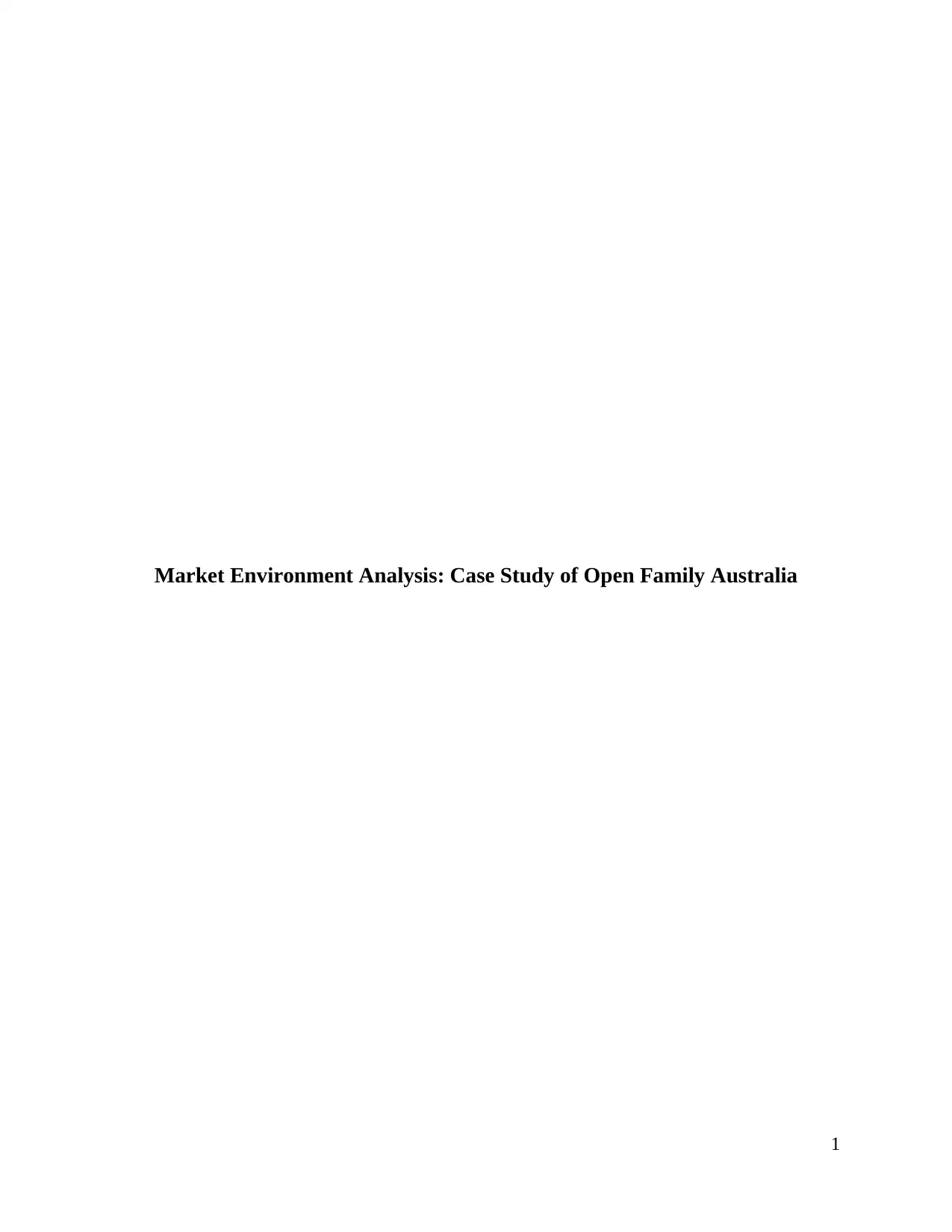
Market Environment Analysis: Case Study of Open Family Australia
1
1
Paraphrase This Document
Need a fresh take? Get an instant paraphrase of this document with our AI Paraphraser
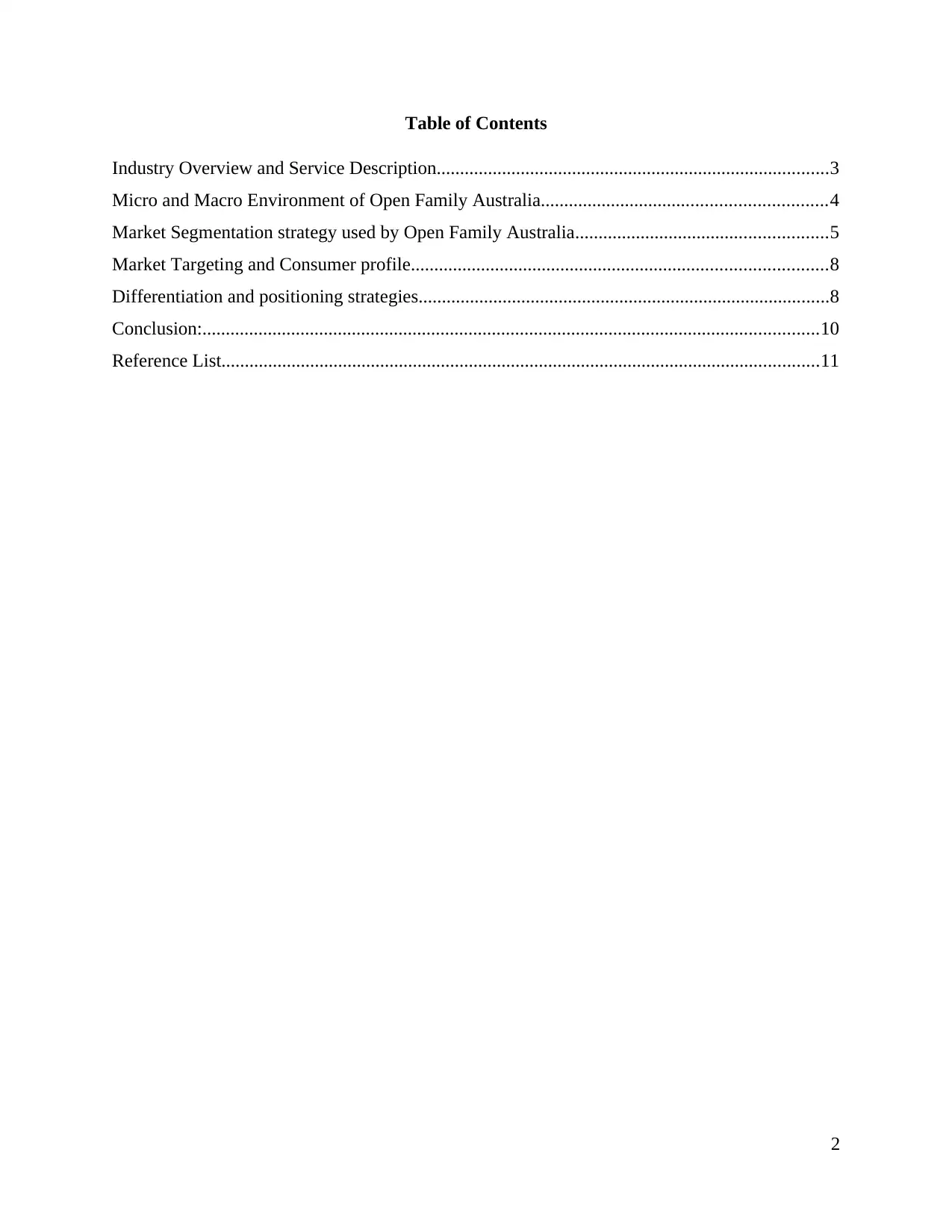
Table of Contents
Industry Overview and Service Description....................................................................................3
Micro and Macro Environment of Open Family Australia.............................................................4
Market Segmentation strategy used by Open Family Australia......................................................5
Market Targeting and Consumer profile.........................................................................................8
Differentiation and positioning strategies........................................................................................8
Conclusion:....................................................................................................................................10
Reference List................................................................................................................................11
2
Industry Overview and Service Description....................................................................................3
Micro and Macro Environment of Open Family Australia.............................................................4
Market Segmentation strategy used by Open Family Australia......................................................5
Market Targeting and Consumer profile.........................................................................................8
Differentiation and positioning strategies........................................................................................8
Conclusion:....................................................................................................................................10
Reference List................................................................................................................................11
2
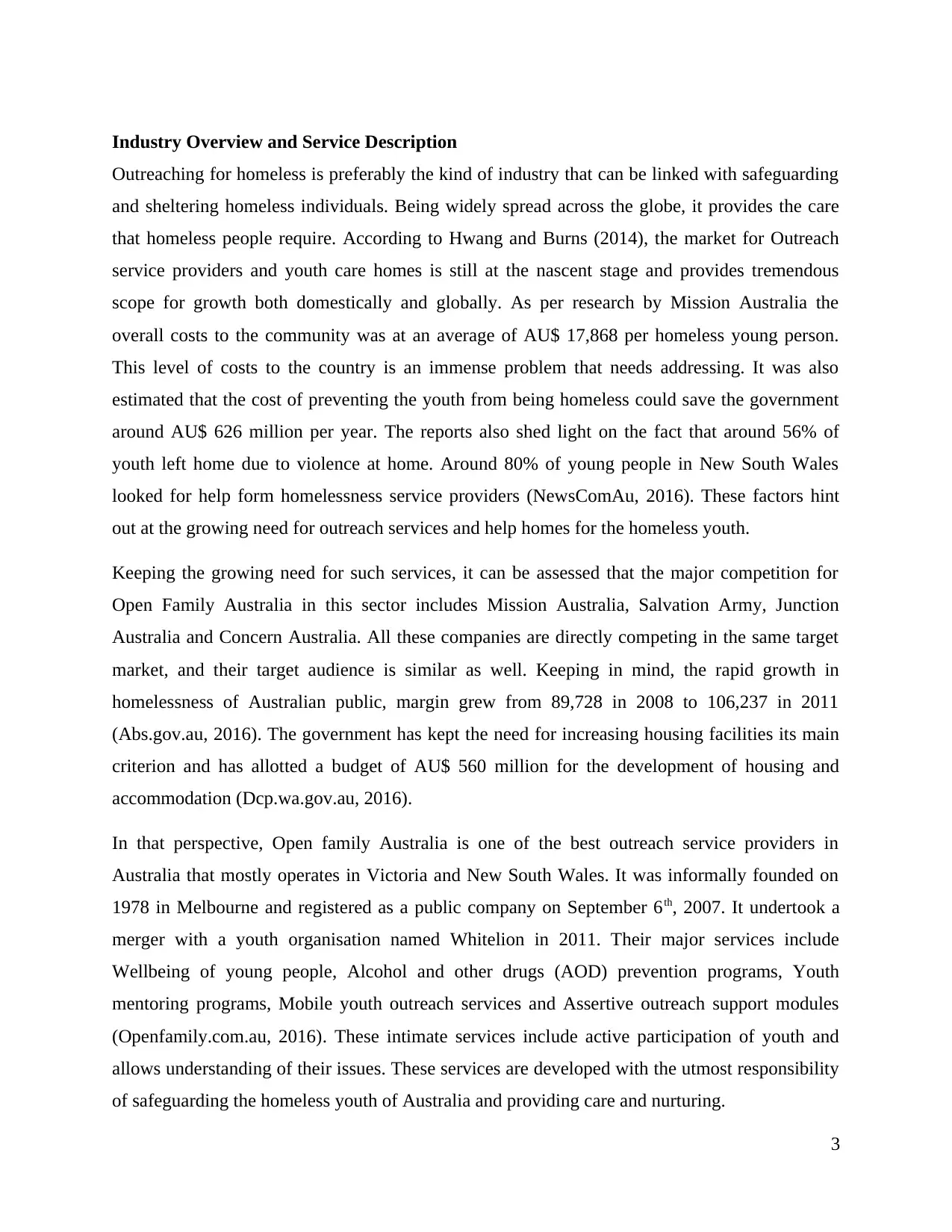
Industry Overview and Service Description
Outreaching for homeless is preferably the kind of industry that can be linked with safeguarding
and sheltering homeless individuals. Being widely spread across the globe, it provides the care
that homeless people require. According to Hwang and Burns (2014), the market for Outreach
service providers and youth care homes is still at the nascent stage and provides tremendous
scope for growth both domestically and globally. As per research by Mission Australia the
overall costs to the community was at an average of AU$ 17,868 per homeless young person.
This level of costs to the country is an immense problem that needs addressing. It was also
estimated that the cost of preventing the youth from being homeless could save the government
around AU$ 626 million per year. The reports also shed light on the fact that around 56% of
youth left home due to violence at home. Around 80% of young people in New South Wales
looked for help form homelessness service providers (NewsComAu, 2016). These factors hint
out at the growing need for outreach services and help homes for the homeless youth.
Keeping the growing need for such services, it can be assessed that the major competition for
Open Family Australia in this sector includes Mission Australia, Salvation Army, Junction
Australia and Concern Australia. All these companies are directly competing in the same target
market, and their target audience is similar as well. Keeping in mind, the rapid growth in
homelessness of Australian public, margin grew from 89,728 in 2008 to 106,237 in 2011
(Abs.gov.au, 2016). The government has kept the need for increasing housing facilities its main
criterion and has allotted a budget of AU$ 560 million for the development of housing and
accommodation (Dcp.wa.gov.au, 2016).
In that perspective, Open family Australia is one of the best outreach service providers in
Australia that mostly operates in Victoria and New South Wales. It was informally founded on
1978 in Melbourne and registered as a public company on September 6th, 2007. It undertook a
merger with a youth organisation named Whitelion in 2011. Their major services include
Wellbeing of young people, Alcohol and other drugs (AOD) prevention programs, Youth
mentoring programs, Mobile youth outreach services and Assertive outreach support modules
(Openfamily.com.au, 2016). These intimate services include active participation of youth and
allows understanding of their issues. These services are developed with the utmost responsibility
of safeguarding the homeless youth of Australia and providing care and nurturing.
3
Outreaching for homeless is preferably the kind of industry that can be linked with safeguarding
and sheltering homeless individuals. Being widely spread across the globe, it provides the care
that homeless people require. According to Hwang and Burns (2014), the market for Outreach
service providers and youth care homes is still at the nascent stage and provides tremendous
scope for growth both domestically and globally. As per research by Mission Australia the
overall costs to the community was at an average of AU$ 17,868 per homeless young person.
This level of costs to the country is an immense problem that needs addressing. It was also
estimated that the cost of preventing the youth from being homeless could save the government
around AU$ 626 million per year. The reports also shed light on the fact that around 56% of
youth left home due to violence at home. Around 80% of young people in New South Wales
looked for help form homelessness service providers (NewsComAu, 2016). These factors hint
out at the growing need for outreach services and help homes for the homeless youth.
Keeping the growing need for such services, it can be assessed that the major competition for
Open Family Australia in this sector includes Mission Australia, Salvation Army, Junction
Australia and Concern Australia. All these companies are directly competing in the same target
market, and their target audience is similar as well. Keeping in mind, the rapid growth in
homelessness of Australian public, margin grew from 89,728 in 2008 to 106,237 in 2011
(Abs.gov.au, 2016). The government has kept the need for increasing housing facilities its main
criterion and has allotted a budget of AU$ 560 million for the development of housing and
accommodation (Dcp.wa.gov.au, 2016).
In that perspective, Open family Australia is one of the best outreach service providers in
Australia that mostly operates in Victoria and New South Wales. It was informally founded on
1978 in Melbourne and registered as a public company on September 6th, 2007. It undertook a
merger with a youth organisation named Whitelion in 2011. Their major services include
Wellbeing of young people, Alcohol and other drugs (AOD) prevention programs, Youth
mentoring programs, Mobile youth outreach services and Assertive outreach support modules
(Openfamily.com.au, 2016). These intimate services include active participation of youth and
allows understanding of their issues. These services are developed with the utmost responsibility
of safeguarding the homeless youth of Australia and providing care and nurturing.
3
⊘ This is a preview!⊘
Do you want full access?
Subscribe today to unlock all pages.

Trusted by 1+ million students worldwide
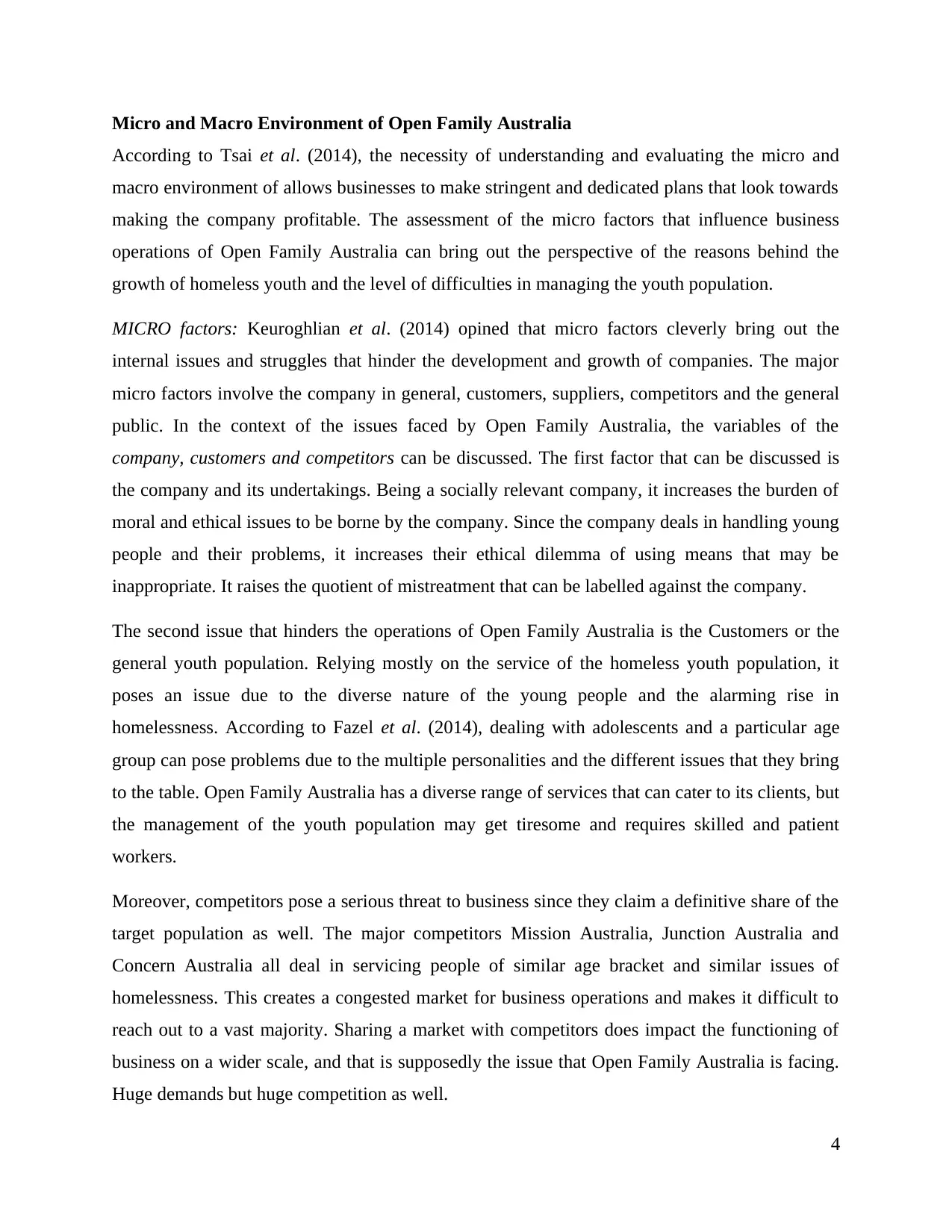
Micro and Macro Environment of Open Family Australia
According to Tsai et al. (2014), the necessity of understanding and evaluating the micro and
macro environment of allows businesses to make stringent and dedicated plans that look towards
making the company profitable. The assessment of the micro factors that influence business
operations of Open Family Australia can bring out the perspective of the reasons behind the
growth of homeless youth and the level of difficulties in managing the youth population.
MICRO factors: Keuroghlian et al. (2014) opined that micro factors cleverly bring out the
internal issues and struggles that hinder the development and growth of companies. The major
micro factors involve the company in general, customers, suppliers, competitors and the general
public. In the context of the issues faced by Open Family Australia, the variables of the
company, customers and competitors can be discussed. The first factor that can be discussed is
the company and its undertakings. Being a socially relevant company, it increases the burden of
moral and ethical issues to be borne by the company. Since the company deals in handling young
people and their problems, it increases their ethical dilemma of using means that may be
inappropriate. It raises the quotient of mistreatment that can be labelled against the company.
The second issue that hinders the operations of Open Family Australia is the Customers or the
general youth population. Relying mostly on the service of the homeless youth population, it
poses an issue due to the diverse nature of the young people and the alarming rise in
homelessness. According to Fazel et al. (2014), dealing with adolescents and a particular age
group can pose problems due to the multiple personalities and the different issues that they bring
to the table. Open Family Australia has a diverse range of services that can cater to its clients, but
the management of the youth population may get tiresome and requires skilled and patient
workers.
Moreover, competitors pose a serious threat to business since they claim a definitive share of the
target population as well. The major competitors Mission Australia, Junction Australia and
Concern Australia all deal in servicing people of similar age bracket and similar issues of
homelessness. This creates a congested market for business operations and makes it difficult to
reach out to a vast majority. Sharing a market with competitors does impact the functioning of
business on a wider scale, and that is supposedly the issue that Open Family Australia is facing.
Huge demands but huge competition as well.
4
According to Tsai et al. (2014), the necessity of understanding and evaluating the micro and
macro environment of allows businesses to make stringent and dedicated plans that look towards
making the company profitable. The assessment of the micro factors that influence business
operations of Open Family Australia can bring out the perspective of the reasons behind the
growth of homeless youth and the level of difficulties in managing the youth population.
MICRO factors: Keuroghlian et al. (2014) opined that micro factors cleverly bring out the
internal issues and struggles that hinder the development and growth of companies. The major
micro factors involve the company in general, customers, suppliers, competitors and the general
public. In the context of the issues faced by Open Family Australia, the variables of the
company, customers and competitors can be discussed. The first factor that can be discussed is
the company and its undertakings. Being a socially relevant company, it increases the burden of
moral and ethical issues to be borne by the company. Since the company deals in handling young
people and their problems, it increases their ethical dilemma of using means that may be
inappropriate. It raises the quotient of mistreatment that can be labelled against the company.
The second issue that hinders the operations of Open Family Australia is the Customers or the
general youth population. Relying mostly on the service of the homeless youth population, it
poses an issue due to the diverse nature of the young people and the alarming rise in
homelessness. According to Fazel et al. (2014), dealing with adolescents and a particular age
group can pose problems due to the multiple personalities and the different issues that they bring
to the table. Open Family Australia has a diverse range of services that can cater to its clients, but
the management of the youth population may get tiresome and requires skilled and patient
workers.
Moreover, competitors pose a serious threat to business since they claim a definitive share of the
target population as well. The major competitors Mission Australia, Junction Australia and
Concern Australia all deal in servicing people of similar age bracket and similar issues of
homelessness. This creates a congested market for business operations and makes it difficult to
reach out to a vast majority. Sharing a market with competitors does impact the functioning of
business on a wider scale, and that is supposedly the issue that Open Family Australia is facing.
Huge demands but huge competition as well.
4
Paraphrase This Document
Need a fresh take? Get an instant paraphrase of this document with our AI Paraphraser
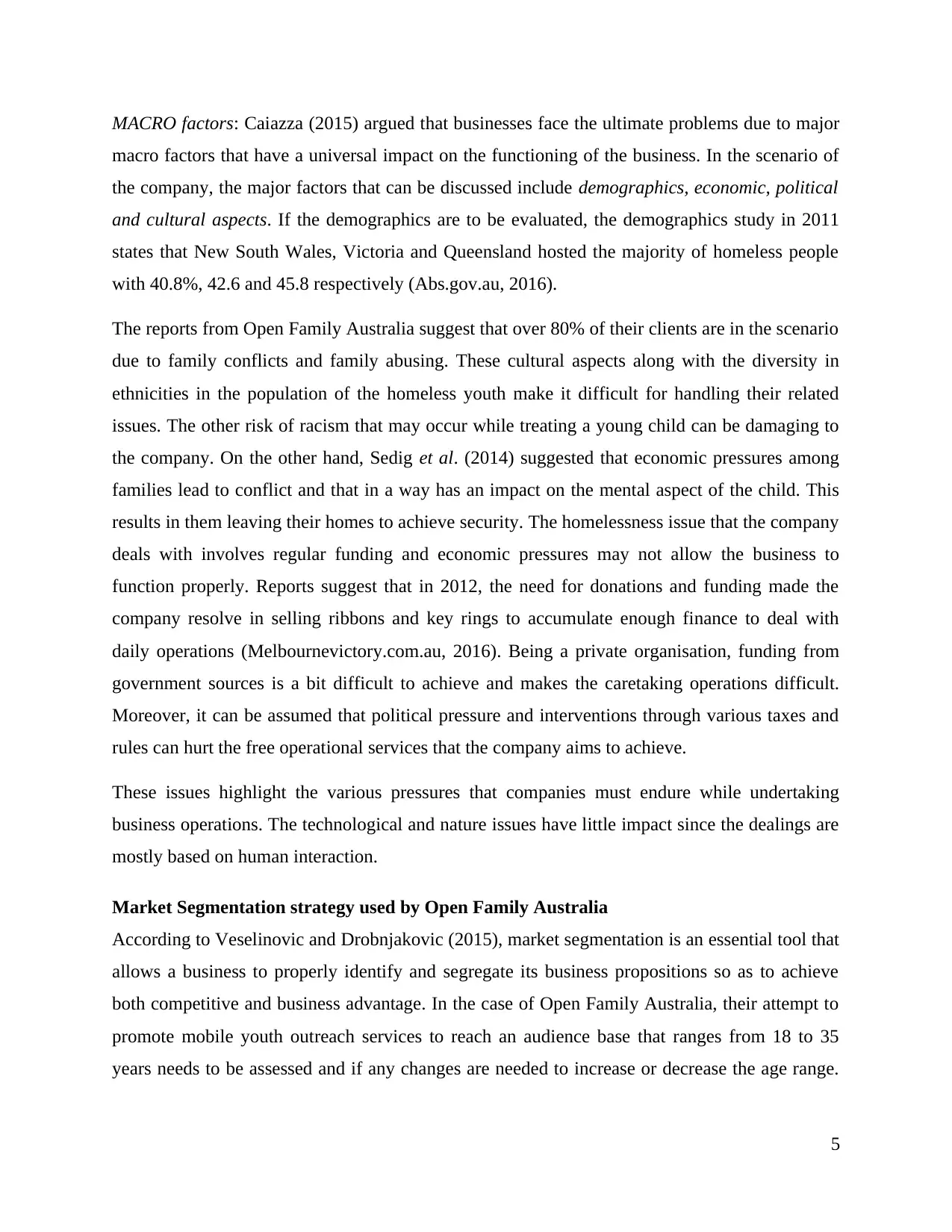
MACRO factors: Caiazza (2015) argued that businesses face the ultimate problems due to major
macro factors that have a universal impact on the functioning of the business. In the scenario of
the company, the major factors that can be discussed include demographics, economic, political
and cultural aspects. If the demographics are to be evaluated, the demographics study in 2011
states that New South Wales, Victoria and Queensland hosted the majority of homeless people
with 40.8%, 42.6 and 45.8 respectively (Abs.gov.au, 2016).
The reports from Open Family Australia suggest that over 80% of their clients are in the scenario
due to family conflicts and family abusing. These cultural aspects along with the diversity in
ethnicities in the population of the homeless youth make it difficult for handling their related
issues. The other risk of racism that may occur while treating a young child can be damaging to
the company. On the other hand, Sedig et al. (2014) suggested that economic pressures among
families lead to conflict and that in a way has an impact on the mental aspect of the child. This
results in them leaving their homes to achieve security. The homelessness issue that the company
deals with involves regular funding and economic pressures may not allow the business to
function properly. Reports suggest that in 2012, the need for donations and funding made the
company resolve in selling ribbons and key rings to accumulate enough finance to deal with
daily operations (Melbournevictory.com.au, 2016). Being a private organisation, funding from
government sources is a bit difficult to achieve and makes the caretaking operations difficult.
Moreover, it can be assumed that political pressure and interventions through various taxes and
rules can hurt the free operational services that the company aims to achieve.
These issues highlight the various pressures that companies must endure while undertaking
business operations. The technological and nature issues have little impact since the dealings are
mostly based on human interaction.
Market Segmentation strategy used by Open Family Australia
According to Veselinovic and Drobnjakovic (2015), market segmentation is an essential tool that
allows a business to properly identify and segregate its business propositions so as to achieve
both competitive and business advantage. In the case of Open Family Australia, their attempt to
promote mobile youth outreach services to reach an audience base that ranges from 18 to 35
years needs to be assessed and if any changes are needed to increase or decrease the age range.
5
macro factors that have a universal impact on the functioning of the business. In the scenario of
the company, the major factors that can be discussed include demographics, economic, political
and cultural aspects. If the demographics are to be evaluated, the demographics study in 2011
states that New South Wales, Victoria and Queensland hosted the majority of homeless people
with 40.8%, 42.6 and 45.8 respectively (Abs.gov.au, 2016).
The reports from Open Family Australia suggest that over 80% of their clients are in the scenario
due to family conflicts and family abusing. These cultural aspects along with the diversity in
ethnicities in the population of the homeless youth make it difficult for handling their related
issues. The other risk of racism that may occur while treating a young child can be damaging to
the company. On the other hand, Sedig et al. (2014) suggested that economic pressures among
families lead to conflict and that in a way has an impact on the mental aspect of the child. This
results in them leaving their homes to achieve security. The homelessness issue that the company
deals with involves regular funding and economic pressures may not allow the business to
function properly. Reports suggest that in 2012, the need for donations and funding made the
company resolve in selling ribbons and key rings to accumulate enough finance to deal with
daily operations (Melbournevictory.com.au, 2016). Being a private organisation, funding from
government sources is a bit difficult to achieve and makes the caretaking operations difficult.
Moreover, it can be assumed that political pressure and interventions through various taxes and
rules can hurt the free operational services that the company aims to achieve.
These issues highlight the various pressures that companies must endure while undertaking
business operations. The technological and nature issues have little impact since the dealings are
mostly based on human interaction.
Market Segmentation strategy used by Open Family Australia
According to Veselinovic and Drobnjakovic (2015), market segmentation is an essential tool that
allows a business to properly identify and segregate its business propositions so as to achieve
both competitive and business advantage. In the case of Open Family Australia, their attempt to
promote mobile youth outreach services to reach an audience base that ranges from 18 to 35
years needs to be assessed and if any changes are needed to increase or decrease the age range.
5
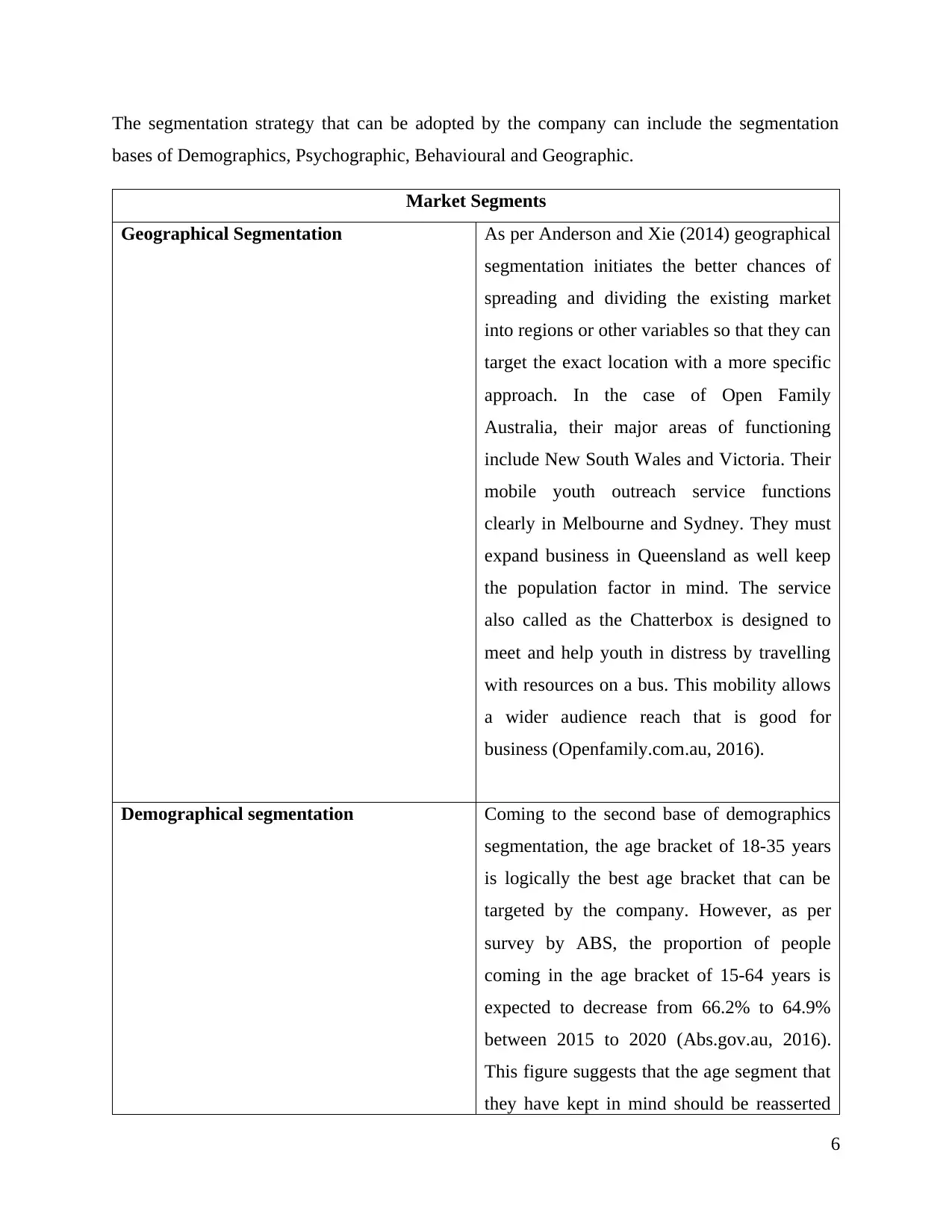
The segmentation strategy that can be adopted by the company can include the segmentation
bases of Demographics, Psychographic, Behavioural and Geographic.
Market Segments
Geographical Segmentation As per Anderson and Xie (2014) geographical
segmentation initiates the better chances of
spreading and dividing the existing market
into regions or other variables so that they can
target the exact location with a more specific
approach. In the case of Open Family
Australia, their major areas of functioning
include New South Wales and Victoria. Their
mobile youth outreach service functions
clearly in Melbourne and Sydney. They must
expand business in Queensland as well keep
the population factor in mind. The service
also called as the Chatterbox is designed to
meet and help youth in distress by travelling
with resources on a bus. This mobility allows
a wider audience reach that is good for
business (Openfamily.com.au, 2016).
Demographical segmentation Coming to the second base of demographics
segmentation, the age bracket of 18-35 years
is logically the best age bracket that can be
targeted by the company. However, as per
survey by ABS, the proportion of people
coming in the age bracket of 15-64 years is
expected to decrease from 66.2% to 64.9%
between 2015 to 2020 (Abs.gov.au, 2016).
This figure suggests that the age segment that
they have kept in mind should be reasserted
6
bases of Demographics, Psychographic, Behavioural and Geographic.
Market Segments
Geographical Segmentation As per Anderson and Xie (2014) geographical
segmentation initiates the better chances of
spreading and dividing the existing market
into regions or other variables so that they can
target the exact location with a more specific
approach. In the case of Open Family
Australia, their major areas of functioning
include New South Wales and Victoria. Their
mobile youth outreach service functions
clearly in Melbourne and Sydney. They must
expand business in Queensland as well keep
the population factor in mind. The service
also called as the Chatterbox is designed to
meet and help youth in distress by travelling
with resources on a bus. This mobility allows
a wider audience reach that is good for
business (Openfamily.com.au, 2016).
Demographical segmentation Coming to the second base of demographics
segmentation, the age bracket of 18-35 years
is logically the best age bracket that can be
targeted by the company. However, as per
survey by ABS, the proportion of people
coming in the age bracket of 15-64 years is
expected to decrease from 66.2% to 64.9%
between 2015 to 2020 (Abs.gov.au, 2016).
This figure suggests that the age segment that
they have kept in mind should be reasserted
6
⊘ This is a preview!⊘
Do you want full access?
Subscribe today to unlock all pages.

Trusted by 1+ million students worldwide
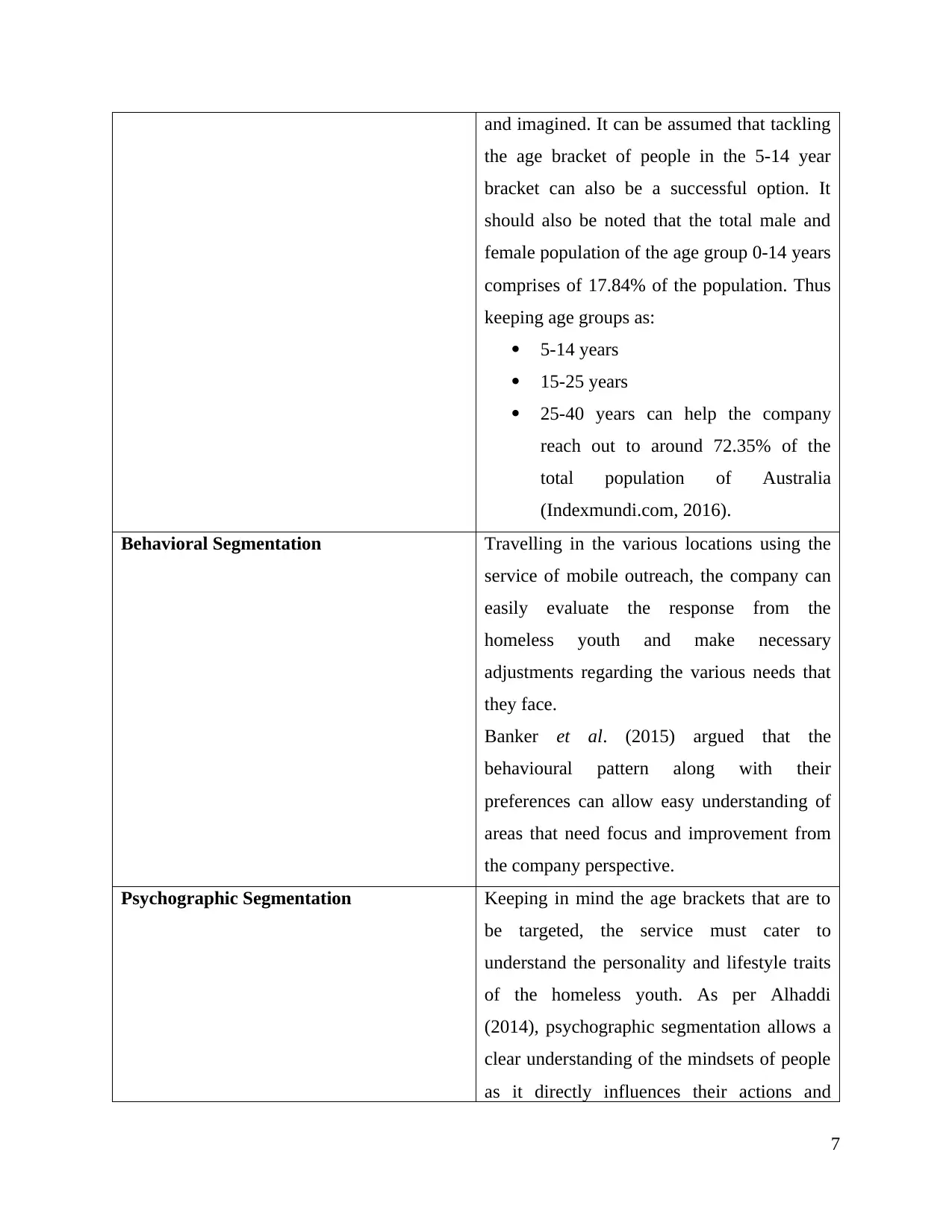
and imagined. It can be assumed that tackling
the age bracket of people in the 5-14 year
bracket can also be a successful option. It
should also be noted that the total male and
female population of the age group 0-14 years
comprises of 17.84% of the population. Thus
keeping age groups as:
5-14 years
15-25 years
25-40 years can help the company
reach out to around 72.35% of the
total population of Australia
(Indexmundi.com, 2016).
Behavioral Segmentation Travelling in the various locations using the
service of mobile outreach, the company can
easily evaluate the response from the
homeless youth and make necessary
adjustments regarding the various needs that
they face.
Banker et al. (2015) argued that the
behavioural pattern along with their
preferences can allow easy understanding of
areas that need focus and improvement from
the company perspective.
Psychographic Segmentation Keeping in mind the age brackets that are to
be targeted, the service must cater to
understand the personality and lifestyle traits
of the homeless youth. As per Alhaddi
(2014), psychographic segmentation allows a
clear understanding of the mindsets of people
as it directly influences their actions and
7
the age bracket of people in the 5-14 year
bracket can also be a successful option. It
should also be noted that the total male and
female population of the age group 0-14 years
comprises of 17.84% of the population. Thus
keeping age groups as:
5-14 years
15-25 years
25-40 years can help the company
reach out to around 72.35% of the
total population of Australia
(Indexmundi.com, 2016).
Behavioral Segmentation Travelling in the various locations using the
service of mobile outreach, the company can
easily evaluate the response from the
homeless youth and make necessary
adjustments regarding the various needs that
they face.
Banker et al. (2015) argued that the
behavioural pattern along with their
preferences can allow easy understanding of
areas that need focus and improvement from
the company perspective.
Psychographic Segmentation Keeping in mind the age brackets that are to
be targeted, the service must cater to
understand the personality and lifestyle traits
of the homeless youth. As per Alhaddi
(2014), psychographic segmentation allows a
clear understanding of the mindsets of people
as it directly influences their actions and
7
Paraphrase This Document
Need a fresh take? Get an instant paraphrase of this document with our AI Paraphraser
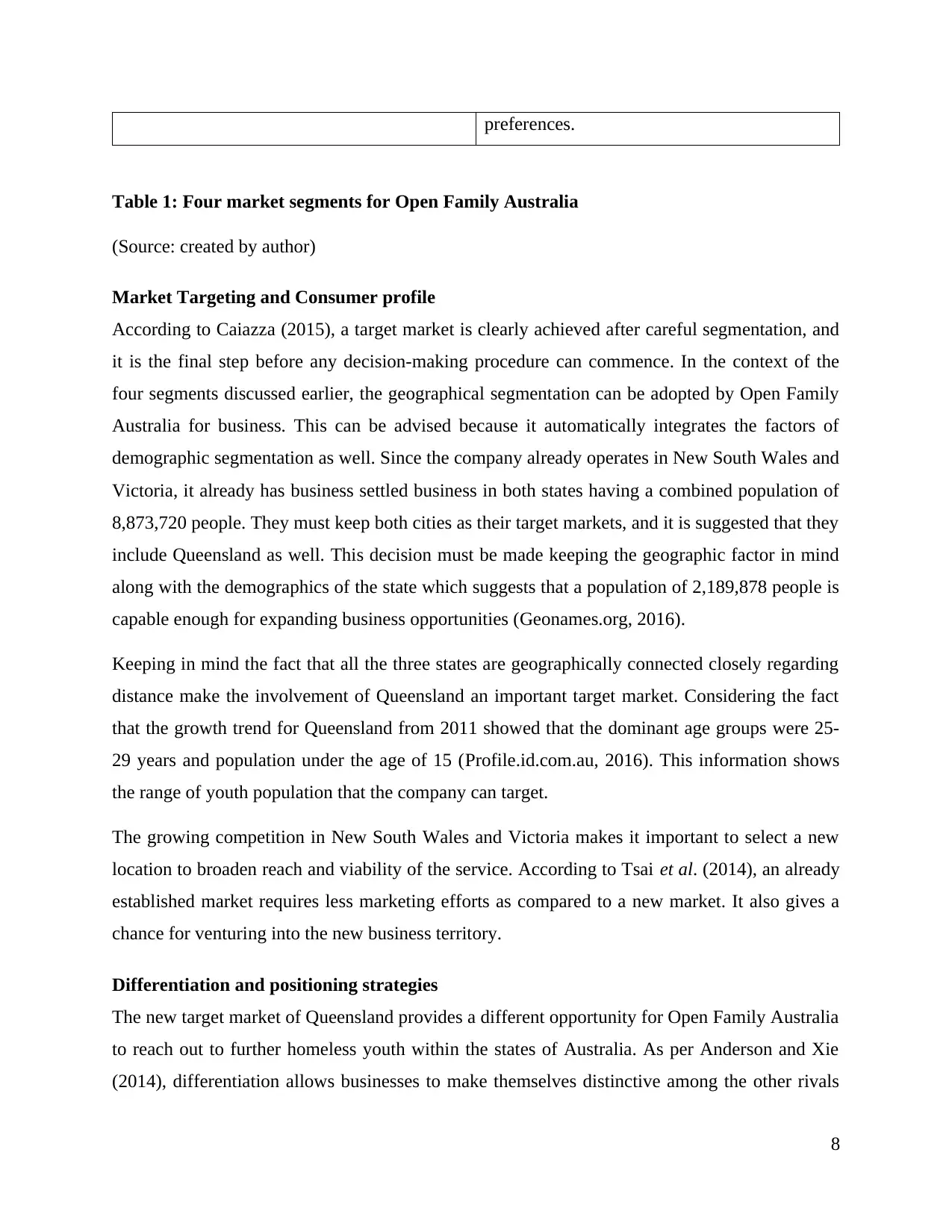
preferences.
Table 1: Four market segments for Open Family Australia
(Source: created by author)
Market Targeting and Consumer profile
According to Caiazza (2015), a target market is clearly achieved after careful segmentation, and
it is the final step before any decision-making procedure can commence. In the context of the
four segments discussed earlier, the geographical segmentation can be adopted by Open Family
Australia for business. This can be advised because it automatically integrates the factors of
demographic segmentation as well. Since the company already operates in New South Wales and
Victoria, it already has business settled business in both states having a combined population of
8,873,720 people. They must keep both cities as their target markets, and it is suggested that they
include Queensland as well. This decision must be made keeping the geographic factor in mind
along with the demographics of the state which suggests that a population of 2,189,878 people is
capable enough for expanding business opportunities (Geonames.org, 2016).
Keeping in mind the fact that all the three states are geographically connected closely regarding
distance make the involvement of Queensland an important target market. Considering the fact
that the growth trend for Queensland from 2011 showed that the dominant age groups were 25-
29 years and population under the age of 15 (Profile.id.com.au, 2016). This information shows
the range of youth population that the company can target.
The growing competition in New South Wales and Victoria makes it important to select a new
location to broaden reach and viability of the service. According to Tsai et al. (2014), an already
established market requires less marketing efforts as compared to a new market. It also gives a
chance for venturing into the new business territory.
Differentiation and positioning strategies
The new target market of Queensland provides a different opportunity for Open Family Australia
to reach out to further homeless youth within the states of Australia. As per Anderson and Xie
(2014), differentiation allows businesses to make themselves distinctive among the other rivals
8
Table 1: Four market segments for Open Family Australia
(Source: created by author)
Market Targeting and Consumer profile
According to Caiazza (2015), a target market is clearly achieved after careful segmentation, and
it is the final step before any decision-making procedure can commence. In the context of the
four segments discussed earlier, the geographical segmentation can be adopted by Open Family
Australia for business. This can be advised because it automatically integrates the factors of
demographic segmentation as well. Since the company already operates in New South Wales and
Victoria, it already has business settled business in both states having a combined population of
8,873,720 people. They must keep both cities as their target markets, and it is suggested that they
include Queensland as well. This decision must be made keeping the geographic factor in mind
along with the demographics of the state which suggests that a population of 2,189,878 people is
capable enough for expanding business opportunities (Geonames.org, 2016).
Keeping in mind the fact that all the three states are geographically connected closely regarding
distance make the involvement of Queensland an important target market. Considering the fact
that the growth trend for Queensland from 2011 showed that the dominant age groups were 25-
29 years and population under the age of 15 (Profile.id.com.au, 2016). This information shows
the range of youth population that the company can target.
The growing competition in New South Wales and Victoria makes it important to select a new
location to broaden reach and viability of the service. According to Tsai et al. (2014), an already
established market requires less marketing efforts as compared to a new market. It also gives a
chance for venturing into the new business territory.
Differentiation and positioning strategies
The new target market of Queensland provides a different opportunity for Open Family Australia
to reach out to further homeless youth within the states of Australia. As per Anderson and Xie
(2014), differentiation allows businesses to make themselves distinctive among the other rivals
8
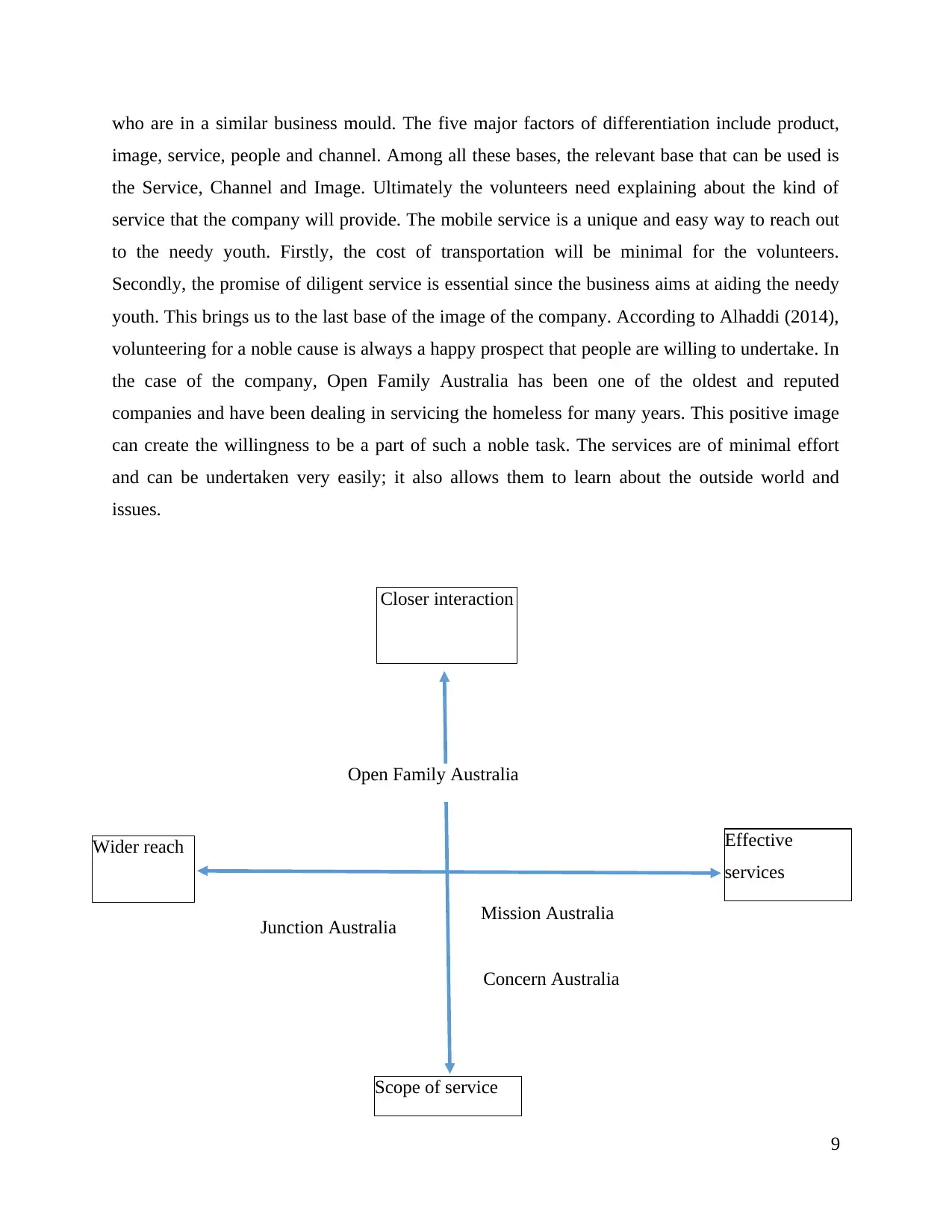
who are in a similar business mould. The five major factors of differentiation include product,
image, service, people and channel. Among all these bases, the relevant base that can be used is
the Service, Channel and Image. Ultimately the volunteers need explaining about the kind of
service that the company will provide. The mobile service is a unique and easy way to reach out
to the needy youth. Firstly, the cost of transportation will be minimal for the volunteers.
Secondly, the promise of diligent service is essential since the business aims at aiding the needy
youth. This brings us to the last base of the image of the company. According to Alhaddi (2014),
volunteering for a noble cause is always a happy prospect that people are willing to undertake. In
the case of the company, Open Family Australia has been one of the oldest and reputed
companies and have been dealing in servicing the homeless for many years. This positive image
can create the willingness to be a part of such a noble task. The services are of minimal effort
and can be undertaken very easily; it also allows them to learn about the outside world and
issues.
9
Junction Australia
Concern Australia
Mission Australia
Open Family Australia
Scope of service
Wider reach Effective
services
Closer interaction
image, service, people and channel. Among all these bases, the relevant base that can be used is
the Service, Channel and Image. Ultimately the volunteers need explaining about the kind of
service that the company will provide. The mobile service is a unique and easy way to reach out
to the needy youth. Firstly, the cost of transportation will be minimal for the volunteers.
Secondly, the promise of diligent service is essential since the business aims at aiding the needy
youth. This brings us to the last base of the image of the company. According to Alhaddi (2014),
volunteering for a noble cause is always a happy prospect that people are willing to undertake. In
the case of the company, Open Family Australia has been one of the oldest and reputed
companies and have been dealing in servicing the homeless for many years. This positive image
can create the willingness to be a part of such a noble task. The services are of minimal effort
and can be undertaken very easily; it also allows them to learn about the outside world and
issues.
9
Junction Australia
Concern Australia
Mission Australia
Open Family Australia
Scope of service
Wider reach Effective
services
Closer interaction
⊘ This is a preview!⊘
Do you want full access?
Subscribe today to unlock all pages.

Trusted by 1+ million students worldwide
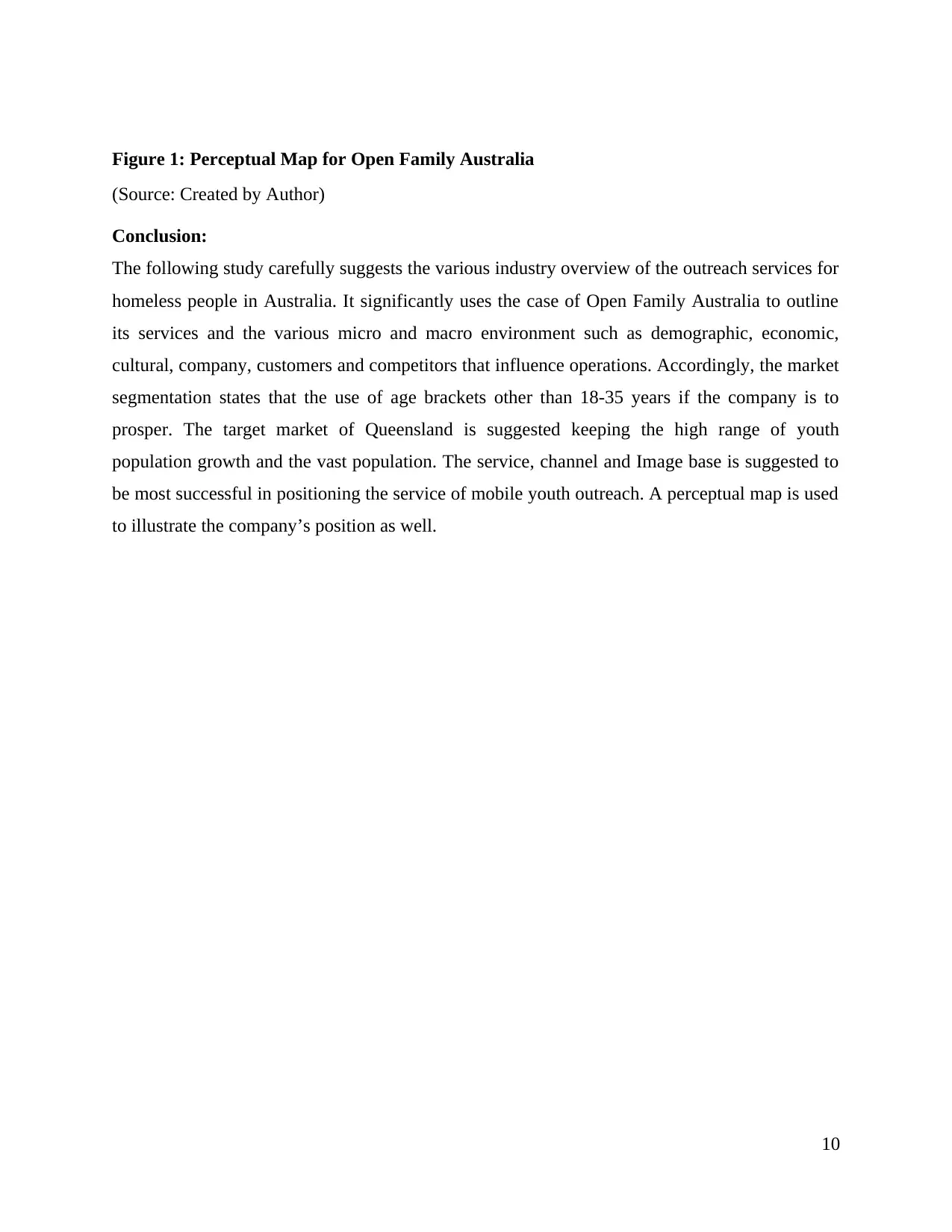
Figure 1: Perceptual Map for Open Family Australia
(Source: Created by Author)
Conclusion:
The following study carefully suggests the various industry overview of the outreach services for
homeless people in Australia. It significantly uses the case of Open Family Australia to outline
its services and the various micro and macro environment such as demographic, economic,
cultural, company, customers and competitors that influence operations. Accordingly, the market
segmentation states that the use of age brackets other than 18-35 years if the company is to
prosper. The target market of Queensland is suggested keeping the high range of youth
population growth and the vast population. The service, channel and Image base is suggested to
be most successful in positioning the service of mobile youth outreach. A perceptual map is used
to illustrate the company’s position as well.
10
(Source: Created by Author)
Conclusion:
The following study carefully suggests the various industry overview of the outreach services for
homeless people in Australia. It significantly uses the case of Open Family Australia to outline
its services and the various micro and macro environment such as demographic, economic,
cultural, company, customers and competitors that influence operations. Accordingly, the market
segmentation states that the use of age brackets other than 18-35 years if the company is to
prosper. The target market of Queensland is suggested keeping the high range of youth
population growth and the vast population. The service, channel and Image base is suggested to
be most successful in positioning the service of mobile youth outreach. A perceptual map is used
to illustrate the company’s position as well.
10
Paraphrase This Document
Need a fresh take? Get an instant paraphrase of this document with our AI Paraphraser
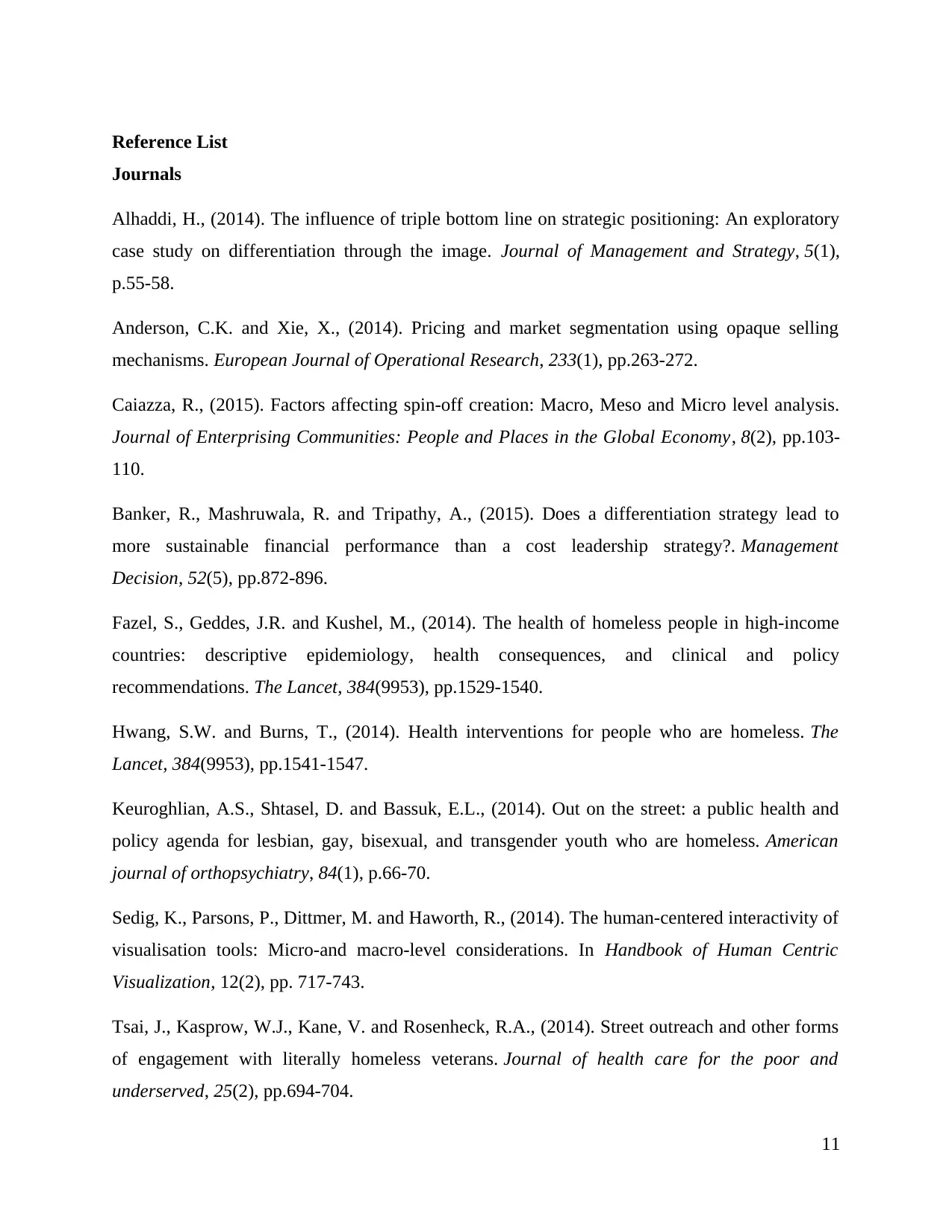
Reference List
Journals
Alhaddi, H., (2014). The influence of triple bottom line on strategic positioning: An exploratory
case study on differentiation through the image. Journal of Management and Strategy, 5(1),
p.55-58.
Anderson, C.K. and Xie, X., (2014). Pricing and market segmentation using opaque selling
mechanisms. European Journal of Operational Research, 233(1), pp.263-272.
Caiazza, R., (2015). Factors affecting spin-off creation: Macro, Meso and Micro level analysis.
Journal of Enterprising Communities: People and Places in the Global Economy, 8(2), pp.103-
110.
Banker, R., Mashruwala, R. and Tripathy, A., (2015). Does a differentiation strategy lead to
more sustainable financial performance than a cost leadership strategy?. Management
Decision, 52(5), pp.872-896.
Fazel, S., Geddes, J.R. and Kushel, M., (2014). The health of homeless people in high-income
countries: descriptive epidemiology, health consequences, and clinical and policy
recommendations. The Lancet, 384(9953), pp.1529-1540.
Hwang, S.W. and Burns, T., (2014). Health interventions for people who are homeless. The
Lancet, 384(9953), pp.1541-1547.
Keuroghlian, A.S., Shtasel, D. and Bassuk, E.L., (2014). Out on the street: a public health and
policy agenda for lesbian, gay, bisexual, and transgender youth who are homeless. American
journal of orthopsychiatry, 84(1), p.66-70.
Sedig, K., Parsons, P., Dittmer, M. and Haworth, R., (2014). The human-centered interactivity of
visualisation tools: Micro-and macro-level considerations. In Handbook of Human Centric
Visualization, 12(2), pp. 717-743.
Tsai, J., Kasprow, W.J., Kane, V. and Rosenheck, R.A., (2014). Street outreach and other forms
of engagement with literally homeless veterans. Journal of health care for the poor and
underserved, 25(2), pp.694-704.
11
Journals
Alhaddi, H., (2014). The influence of triple bottom line on strategic positioning: An exploratory
case study on differentiation through the image. Journal of Management and Strategy, 5(1),
p.55-58.
Anderson, C.K. and Xie, X., (2014). Pricing and market segmentation using opaque selling
mechanisms. European Journal of Operational Research, 233(1), pp.263-272.
Caiazza, R., (2015). Factors affecting spin-off creation: Macro, Meso and Micro level analysis.
Journal of Enterprising Communities: People and Places in the Global Economy, 8(2), pp.103-
110.
Banker, R., Mashruwala, R. and Tripathy, A., (2015). Does a differentiation strategy lead to
more sustainable financial performance than a cost leadership strategy?. Management
Decision, 52(5), pp.872-896.
Fazel, S., Geddes, J.R. and Kushel, M., (2014). The health of homeless people in high-income
countries: descriptive epidemiology, health consequences, and clinical and policy
recommendations. The Lancet, 384(9953), pp.1529-1540.
Hwang, S.W. and Burns, T., (2014). Health interventions for people who are homeless. The
Lancet, 384(9953), pp.1541-1547.
Keuroghlian, A.S., Shtasel, D. and Bassuk, E.L., (2014). Out on the street: a public health and
policy agenda for lesbian, gay, bisexual, and transgender youth who are homeless. American
journal of orthopsychiatry, 84(1), p.66-70.
Sedig, K., Parsons, P., Dittmer, M. and Haworth, R., (2014). The human-centered interactivity of
visualisation tools: Micro-and macro-level considerations. In Handbook of Human Centric
Visualization, 12(2), pp. 717-743.
Tsai, J., Kasprow, W.J., Kane, V. and Rosenheck, R.A., (2014). Street outreach and other forms
of engagement with literally homeless veterans. Journal of health care for the poor and
underserved, 25(2), pp.694-704.
11
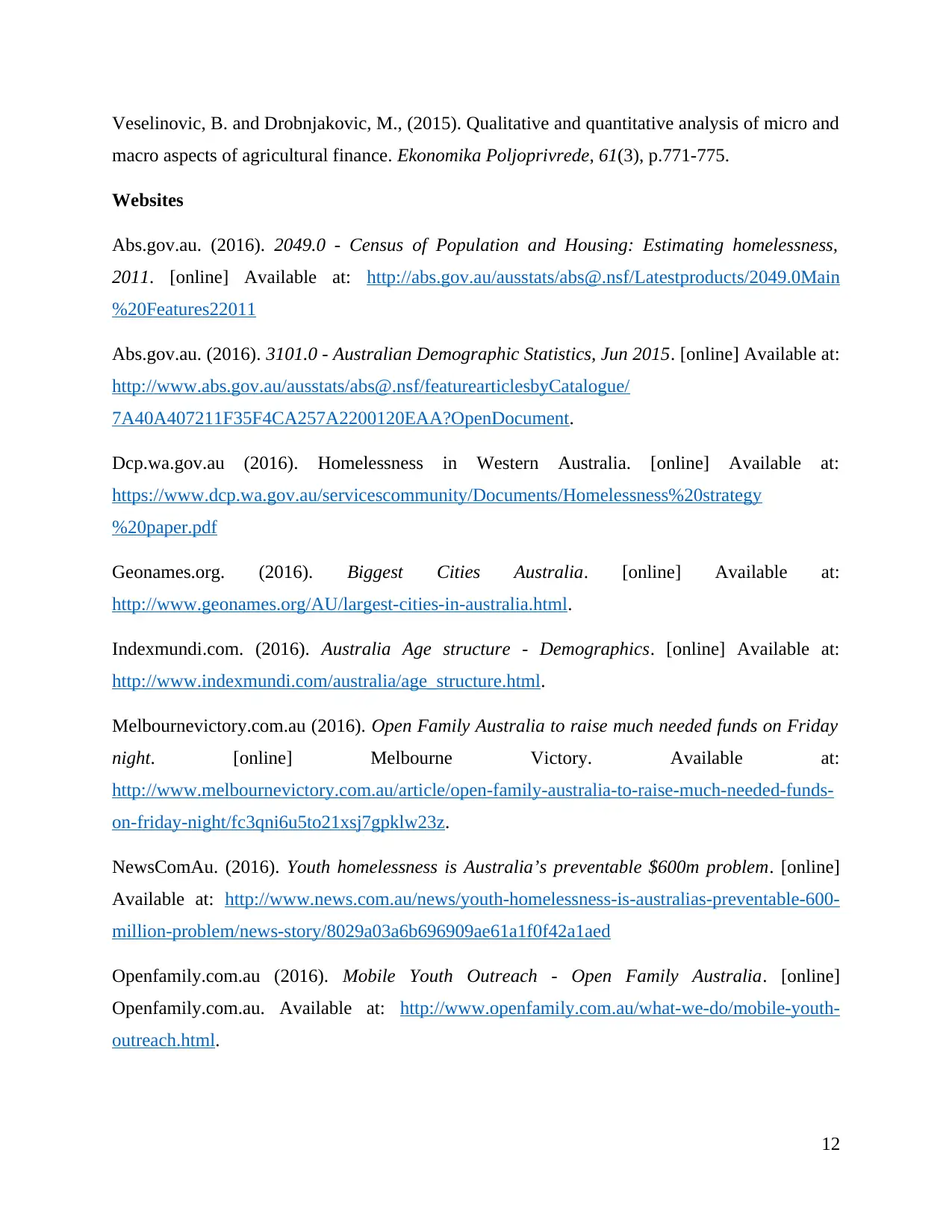
Veselinovic, B. and Drobnjakovic, M., (2015). Qualitative and quantitative analysis of micro and
macro aspects of agricultural finance. Ekonomika Poljoprivrede, 61(3), p.771-775.
Websites
Abs.gov.au. (2016). 2049.0 - Census of Population and Housing: Estimating homelessness,
2011. [online] Available at: http://abs.gov.au/ausstats/abs@.nsf/Latestproducts/2049.0Main
%20Features22011
Abs.gov.au. (2016). 3101.0 - Australian Demographic Statistics, Jun 2015. [online] Available at:
http://www.abs.gov.au/ausstats/abs@.nsf/featurearticlesbyCatalogue/
7A40A407211F35F4CA257A2200120EAA?OpenDocument.
Dcp.wa.gov.au (2016). Homelessness in Western Australia. [online] Available at:
https://www.dcp.wa.gov.au/servicescommunity/Documents/Homelessness%20strategy
%20paper.pdf
Geonames.org. (2016). Biggest Cities Australia. [online] Available at:
http://www.geonames.org/AU/largest-cities-in-australia.html.
Indexmundi.com. (2016). Australia Age structure - Demographics. [online] Available at:
http://www.indexmundi.com/australia/age_structure.html.
Melbournevictory.com.au (2016). Open Family Australia to raise much needed funds on Friday
night. [online] Melbourne Victory. Available at:
http://www.melbournevictory.com.au/article/open-family-australia-to-raise-much-needed-funds-
on-friday-night/fc3qni6u5to21xsj7gpklw23z.
NewsComAu. (2016). Youth homelessness is Australia’s preventable $600m problem. [online]
Available at: http://www.news.com.au/news/youth-homelessness-is-australias-preventable-600-
million-problem/news-story/8029a03a6b696909ae61a1f0f42a1aed
Openfamily.com.au (2016). Mobile Youth Outreach - Open Family Australia. [online]
Openfamily.com.au. Available at: http://www.openfamily.com.au/what-we-do/mobile-youth-
outreach.html.
12
macro aspects of agricultural finance. Ekonomika Poljoprivrede, 61(3), p.771-775.
Websites
Abs.gov.au. (2016). 2049.0 - Census of Population and Housing: Estimating homelessness,
2011. [online] Available at: http://abs.gov.au/ausstats/abs@.nsf/Latestproducts/2049.0Main
%20Features22011
Abs.gov.au. (2016). 3101.0 - Australian Demographic Statistics, Jun 2015. [online] Available at:
http://www.abs.gov.au/ausstats/abs@.nsf/featurearticlesbyCatalogue/
7A40A407211F35F4CA257A2200120EAA?OpenDocument.
Dcp.wa.gov.au (2016). Homelessness in Western Australia. [online] Available at:
https://www.dcp.wa.gov.au/servicescommunity/Documents/Homelessness%20strategy
%20paper.pdf
Geonames.org. (2016). Biggest Cities Australia. [online] Available at:
http://www.geonames.org/AU/largest-cities-in-australia.html.
Indexmundi.com. (2016). Australia Age structure - Demographics. [online] Available at:
http://www.indexmundi.com/australia/age_structure.html.
Melbournevictory.com.au (2016). Open Family Australia to raise much needed funds on Friday
night. [online] Melbourne Victory. Available at:
http://www.melbournevictory.com.au/article/open-family-australia-to-raise-much-needed-funds-
on-friday-night/fc3qni6u5to21xsj7gpklw23z.
NewsComAu. (2016). Youth homelessness is Australia’s preventable $600m problem. [online]
Available at: http://www.news.com.au/news/youth-homelessness-is-australias-preventable-600-
million-problem/news-story/8029a03a6b696909ae61a1f0f42a1aed
Openfamily.com.au (2016). Mobile Youth Outreach - Open Family Australia. [online]
Openfamily.com.au. Available at: http://www.openfamily.com.au/what-we-do/mobile-youth-
outreach.html.
12
⊘ This is a preview!⊘
Do you want full access?
Subscribe today to unlock all pages.

Trusted by 1+ million students worldwide
1 out of 12
Related Documents
Your All-in-One AI-Powered Toolkit for Academic Success.
+13062052269
info@desklib.com
Available 24*7 on WhatsApp / Email
![[object Object]](/_next/static/media/star-bottom.7253800d.svg)
Unlock your academic potential
Copyright © 2020–2025 A2Z Services. All Rights Reserved. Developed and managed by ZUCOL.





